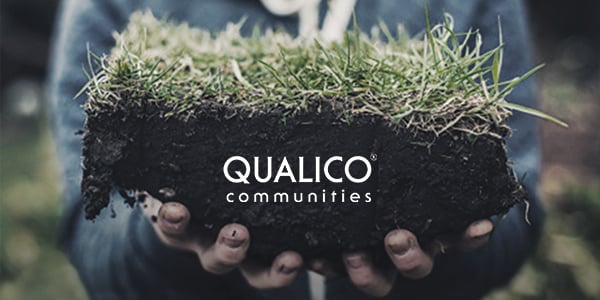Have you ever wondered how a raw piece of land becomes a thriving residential community, complete with roads, houses and parks? It’s a carefully orchestrated sequence of events that starts with a land developer like Qualico Communities. Here, we answer some common questions about the community planning process.
What is a land developer?
Land developers procure property and subsequently lead the planning, engineering, and development of the property into a complete community. To put it another way, a land developer has two things: a large parcel of land and a vision to transform it into a well-designed, cohesive community where people will ultimately live, work, and play.
To propose a new community, the land developer creates a conceptual Community Plan showing road networks, residential and commercial land uses, school sites, parks, and other amenities. The Plan must also incorporate a viable utility network, including water mains, storm and sanitary sewers, electrical, natural gas, and telecommunications. Because of this, the early design stage involves close collaboration with engineers, surveyors and municipal planners, to come up with a Plan that meets the needs of the immediate community while aligning with the broader City Plan. The Community Plan is then presented to City Council for pending approval.
What is the process to prepare the land for home construction?
Once the land is acquired, it typically takes four or more years to have a Community Plan approved and to begin construction on the first homes in the new neighbourhood. This is due to the many technical requirements that must be met before construction can begin. Some of the key items on this extensive checklist are:
- Reports and studies. A comprehensive series of tests and studies are performed on the area to assess elements such as transportation impact, historical considerations, noise, geotechnical and biophysical factors, and the ecological impact on wildlife and plants.
- Engineering. Developers hire engineers to diligently design every detail of our urban environment, and ultimately the municipality approves their design. Engineering design includes (but is not limited to) the slope of roads, the streetlights, the water and sewage drains, storm ponds, landscaping, and park features. The engineers also need to consider the delivery system for electrical, gas, and telecommunication services that we rely on every day, to fuel our appliances or stream our favourite movies.
- Construction. Once the municipality approves the engineering design, developers hire contractors to construct the community in accordance with the approved design. The main construction components include grading to ensure positive drainage is achieved for storm and sanitary sewage, underground utilities such as water and sewer mains, paving and sidewalks, landscaping, as well as power, gas, and telecommunications. Once these components are complete and inspected by the municipality, homes can be built.
Isn’t it the city’s job to put in roads and sewers?
This is a common misconception. The reality is that the City does not typically develop or pay anything toward the development of new communities. The city or municipal Council approves the community plan and zoning, but the land developer leads the process the rest of the way. The land developer typically coordinates and pays for the addition of all infrastructure elements such as roads, sidewalks, sewers, storm ponds, school sites, parks and streetlights.
Who designs the parks and green spaces?
While there is typically a minimum standard, the beautification of the community happens at the discretion and expense of the land developer. At Qualico Communities, we go over and above by integrating family-friendly playgrounds and other attractive outdoor amenities such as parks, multi-use trails, ponds, and sports fields.
Who is responsible for the overall maintenance of the community?
Qualico Communities maintains all facets of a community’s infrastructure for a minimum of 2 years, until we receive a Final Acceptance Certificate (FAC) from the city. When the community passes the city’s inspection, the FAC is issued and the city assumes responsibility for the community’s maintenance.
What is the land developer’s relationship with home builders?
The home builders are our clients and we work closely with them. We establish architectural guidelines based on the overall vision of the community, and the home builders adhere to them. Through our website and other online platforms, we promote each community and provide information for prospective buyers.
Does the land developer interact with homeowners at all?
As the land developer, we work with the home builders, and in turn, they communicate directly with the home buyers. However, we are certainly available to discuss and help in addressing residents’ questions or concerns. We also host community events throughout the year.
At Qualico Communities, our goal is to create communities where residents will be happy to live, work and play. We are continually working to prioritize affordability and accessibility for new home buyers. Infrastructure and development costs are ultimately included in a home’s overall price, so we make every effort to balance the community’s offerings with the need to keep homes affordable for buyers.
Over the course of the entire process, there is a significant amount of thought and consideration that goes into creating a community. We do this to ensure we’re providing a safe and attractive setting for your dream home, with nearby amenities that will enhance your daily life.
To view all our communities in Edmonton and the surrounding area, please visit our website.



